The defeat of the Turkish army in Kyuruk-Dar
Prehistory Battle of Chingil Heights
The start of the 1854 Caucasus campaign of the year was successful for the Russian army, although the Turkish forces were significantly outnumbered by Russians. The princes Eristov and Andronikov in June twice defeated the Batumi corps of the enemy. The Turkish corps under the command of Selim Pasha suffered a complete defeat, suffered heavy losses and was scattered (Beginning of the 1854 Caucasus Campaign of the Year: Victories at Nigoeti and Cholok).
No less successful were the actions of our troops under the command of Lieutenant General Wrangel on the Erivan direction. At the beginning of the campaign, the Russian detachment was located near the village of Igdir, on the road leading from Bayazet, via Orgov, to the Erivan province. In mid-July, Bebutov’s permission to launch an offensive came, as well as wagons and horses for bringing up an artillery fleet and vital supplies.
Karl Karlovich Wrangel, despite the significant superiority of the enemy - up to 9 thousand infantry and 7 thousand cavalry, decided to strike the Ottoman Bayazet corps. This was necessary to ensure border areas from the invasion of small enemy units. The Erivan detachment, due to its small size, could not protect the entire region. Only offensive actions could lead to success and secure the Erivan province. 16 (28) July evening, Russian troops entered from Igdir. The roads were bad, so the entire wagon train was left under the protection of a small cover, taking with it a four-day supply of food, ammunition and empty carts for the sick and wounded. The detachment consisted of 5 battalions and 16 of hundreds of irregular cavalry with 12 guns.
The trip took place in difficult conditions. The troops moved quickly, trying to get ahead of the enemy on the pass. It was raining all night, the road was completely spoiled. A steep climb has become impassable. Early in the morning of July 17 (29), a detachment reached the Orgovsky fasting and made an hour stop. The cavalry entered 6 in the morning, the infantry entered 8. The cavalry was supposed to take heights before the arrival of the enemy. But the Turks were closer, and the road was very bad, so the enemy took the heights before the Russian troops.
The infantry approached the gorge at around noon. The rise was so difficult that Baron Wrangel had to give his troops an hour of rest. General Wrangel left part of the detachment and a light carriage in the rear in order to have a reserve and rear position in case of retreat. Commander of the reserve, Colonel Altukhov. Therefore, 2,9 thousand people remained under his command (1,7 thousand infantry and 1,2 thousand cavalry with 8 guns).
Turkish troops held a strong position. She passed across the gorge between the rocky ridges, in front was a battery of 4 guns, behind them 5 battalions, in the center they were deployed, flanking - stood in a square. Behind the infantry was about 5 thousand irregular cavalry. In addition, about 2 thousand shooters were scattered in front of the main position at heights.
At one o'clock in the afternoon, Turkish troops launched an offensive. Turkish artillery began shelling, and the arrows attacked Russian troops stationed at the flank heights. Wrangell decided to counterattack the enemy with the forces that he had at hand. Given that the main force of the Turkish detachment was infantry, and the cavalry, due to the complexity of the terrain, could not support the attack of the riflemen, Baron Wrangel decided to strike at the center of the enemy position.
Russian guns opened fire on the enemy. General Wrangel built infantry in two lines and led the enemy. For the infantry lines followed by cavalry, built in columns with lavas. The Turks greeted the Russian troops with strong rifle fire and cannonade, first with nuclei, and then with canister. The advanced 5 battalion of the Tiflis Chasseur Regiment suffered heavy losses, losing 100 people killed and wounded in a quarter of an hour. As soon as our first line approached the enemy, a drumbeat was heard, and on command: “on hand”, the Russian troops, screaming “Hurray!”, Rushed at the Ottomans. Simultaneously with the bayonet strike of the infantry, the Cossacks came out on the wings of the first line and hit the Turkish guns and flank Turkish battalions.
Turkish troops could not stand the Russian bayonet battle and Cossack attacks. The success of the case was resolved in a few minutes. The second line did not even have time to join the battle. The front ranks of the Turkish infantry and gunners fell under the blows of bayonets and rush, the rest ran, throwing weapon. The Ottoman cavalry tried to help out their infantry, but was mixed and carried away by the masses of the fleeing. Part of the enemy unit was cut off from the main forces and laid down their arms. Our cavalry drove and chopped the enemy for 6 versts until the horses were tired.
The battle on Chingil heights ended with the complete victory of the Russian troops. Before 2, thousands of Ottomans were killed and wounded, 370 people were captured. 4 guns, 6 banners and 17 badges, a lot of firearms and edged weapons, horses and supplies were captured. The whole Bayazet Corps was demoralized and dissipated, having lost its striking force. The Russian squad lost around 400 people killed and wounded, and another 200 police (volunteers) fled at the beginning of the battle.
Wrangel himself was slightly wounded by a bullet, but until the end of the battle he even forbade dressing up the wound. As a reward for the victory at Chingil Heights, Baron Wrangel was granted the Order of St. George 3 degree. His son, a lieutenant of the Tiflis Chasseur Regiment, who distinguished himself in this battle by capturing the Turkish flag, received the Order of St.. George 4 degree.
This victory led to the capture of Bayazet. 19 (31) July, Russian troops occupied the fortress without a fight. The remnants of the enemy corps fled to Van. The fortress captured 3 guns, large stocks of gunpowder, 2,5 million cartridges, a large amount of provisions and other supplies. This victory greatly influenced the Kurdish tribes. In addition, an important caravan route connecting Turkey with Persia passed along the fortress. The caravans of Trapezunta and Erzurum entered Tabor through Doharskaya gorge, near Bayazet. So, soon the Cossacks intercepted a large caravan in which there were more than 2 thousand horses and camels, and the value of the goods was estimated at 1 million rubles in silver.
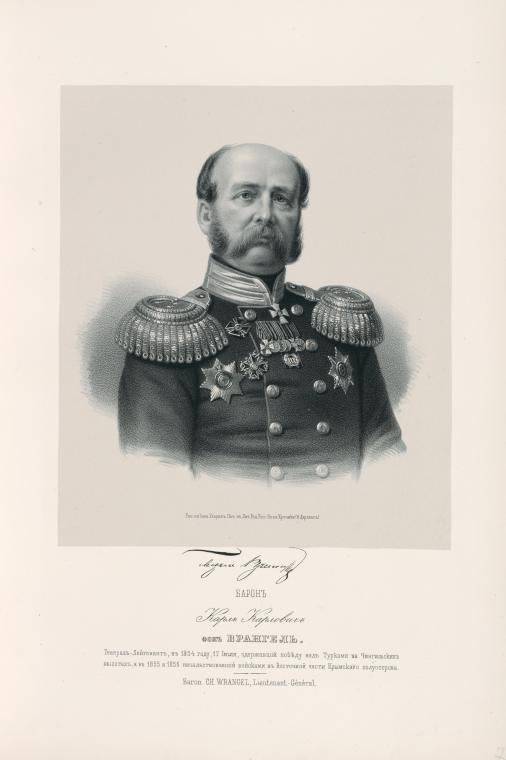
Baron Karl Karlovich Wrangel (1800 — 1872)
Offensive of the Alexandropol Corps
The Alexandropol detachment under the command of Prince Bebutov was reinforced to 22 thousand people with 74 guns. Assistant Bebutov appointed Baryatinsky. The chief of staff in the detachment was Colonel Neverovsky, the chief of artillery was an experienced soldier, Lieutenant General Brimmer. The detachment was well supplied with ammunition and provisions. However, the Alexandropol Corps for a long time did not take offensive action, as it did not have enough strength to storm the strong fortress of Kars.
The main forces of the Turkish army were located in the area of the Kara Fortress - 60 thousand people with 78 guns. At the same time 30 thousand Turkish troops were regular infantry. The commander-in-chief of the Turkish army was Zarif-Mustafa Pasha, the chief of staff was Kurshid Pasha (General Guyon), the adjutant was the English colonel Mefrey. There were many foreign commanders in the Turkish army. The chief of staff of the avant-garde was Colman (Fezi-bey), the head of the bashi-bazouks the Hungarian general Kmeti (Ismail Pasha), the count Bystronovsky (Arslan Pasha), etc.
It must be said that the main difficulty was not in the strong Turkish army, but in the impossibility of the siege of the Kara fortress, which in wartime was greatly strengthened and armed. The Anatolian army could find a safe haven in the fortress or leave, leaving a strong garrison. The passes on the Saganlug ridge were well fortified. In this position, the few Russian corps seriously complicated. Bebutov did not have the strength to simultaneously besiege a strong fortress and put up a barrier against the Turkish army.
But, the troops looked forward to campaigning. Therefore, Bebutov decided to go through Arpachay, make the 2-3 transition, stop to cover the Alexandropol district, and try to call the Anatolian army to a decisive battle. If successful, you could try on the shoulders of the enemy to break into Kars. 14 (26) June Alexandropol Corps crossed the border. Part of the squad was left to protect Alexandropol. The corps reached the village of Kyzyl-Chakhchakh and remained here until June 20 (July 2). From time to time, the advanced patrols engaged in skirmishes with bashi-bazouks.
20 June (2 July) the corps continued its movement and crossed the Kars tea. After passing about 10 versts, the detachment stopped between the villages of Paldervan and Kyuruk-Dara. Until the enemy is about 15 versts. At this point, the corps stood for about a month. Both sides were preparing for a decisive battle. Due to the influence of clean air and good spring water, the epidemic in the 18 Infantry Division has ended. The Alexandropol corps was reinforced by two battalions of the Ryazhsky regiment with 2 guns. From time to time there were clashes between the patrols and the advanced forces of the two armies.
Battle of Kyuruk-Dar
The long inaction of the Russian troops cheered the Ottoman command. General Guyon offered to strike the Russian troops himself, although Mustafa-Zarif-Pasha had instructions from Constantinople, where he was ordered to confine himself to defense and, in the event of a strong attack of the enemy, to retreat to Kars. In preparation for the offensive, the Turks on the night of 22 on July 23 (August 3-4) sent carts to Kars. They planned to make two powerful marching columns: the right column was commanded by Kerim Pasha, the left, more numerous, Ismail Pasha.
Russian horse intelligence has informed Bebutov about the preparations of the enemy. The prince suggested that the Turkish army was retreating, and decided to pursue the enemy and hit the flank and rear of the retreating columns. On the night of 23 on 24 July (from 4 on 5 of August), the Russian corps performed. All heavy loads and knapsacks were left in the wagenburg (mobile field reinforcement). For his protection, the Caucasian Sapper Battalion with two hundred Don Cossacks, a light battery of the 18 artillery brigade and 4 captured Turkish guns were left. Russian troops (total 18 thousand soldiers with 64 guns) moved to the village of Meshko. Thus, both sides were preparing to attack the enemy on the same day.
At dawn, the two armies met and immediately began to deploy battle formations for the battle at Mount Karayal (Kara-Yal). The terrain on which the troops were to fight was fairly flat. The spurs of Karayal rose above the plain, there was a wide ravine from the mountain, which extended to the lowland, which ended in a swamp (it was filled during the rains). Even before the start of the battle, the 4 battalion with the 4 mountain guns from the right wing of the Turkish army managed to occupy the mountain, where the redoubt had previously been built by Russian advanced forces. The Turks opened artillery fire from the mountain, but the distance was so great that there was no harm from their firing.
The Turkish command planned to use a threefold superiority in numbers and attack the main forces of the Russian corps from the front and from the right flank. At this time, the cavalry and bashibuzuki were to cover the Russian detachment from the two flanks and capture the camp (Wagenburg). Turkish regular forces were divided into two parts. The right wing under the command of Kerim Pasha as part of the 19 battalions and 16 squadrons with 32 guns, joining Karayal mountain with the right flank, moved against the Russian corps from the front. The left wing under the command of General Kmeti (Ismail Pasha), consisting of 22 battalions and 22 squadrons, with 48 guns, was intended for a decisive attack on the right flank of the Russian detachment. In general, the Ottoman commanders stretched their army to 8 versts, which condemned it to defeat, if the enemy was able to concentrate an attack fist in one direction at the time.
The battle at the village Kyuryuk-Dar in the vicinity of the fortress of Kars 24 July 1854 year. F.I. Baikov
Left flank. Understanding the importance of Mount Karayal, from where the enemy could strike the flank of his corps, Bebutov sent to storm the mountains, a third of his infantry and cavalry under the overall command of General Belyavsky. The rest of the troops lined up in two battle lines against the Turkish army. Most of the artillery positioned in front. While such a reconstruction was under way, the Turkish troops launched an offensive. Turkish guns led shelling of Russian troops, stepped up to Mount Karayal. Belyavsky could not attack the Turkish positions on the mountain when troops of the right enemy column were attacking him. Belyavsky, leaving the mountain under the supervision of his left-flank battalions, with the 5 battalions of the Belyavsky Chasseurs, Tula and Kavkaz rifle regiments made a front change.
The Tver Dragoon Regiment under the command of Colonel Kukolevsky attacked the flank Turkish battery, which was the most dangerous for our troops. The dragoons rushed forward, silently, without “hurray”, equaling themselves like at a parade, under the command of the regimental commander and commander of the Joint Dragoon Brigade, Major General Count Nyrod. Despite the kartechny fire of two enemy batteries, which acted on them from the front and from the flank, the Russian dragoons swept the Turkish cavalry cover, chopped down the servants and were able to remove the 4 guns. The rest of the 8 guns the Turks hastily led to the rear. This brilliant attack halted the attack of the enemy and made it possible to complete the construction in battle order.
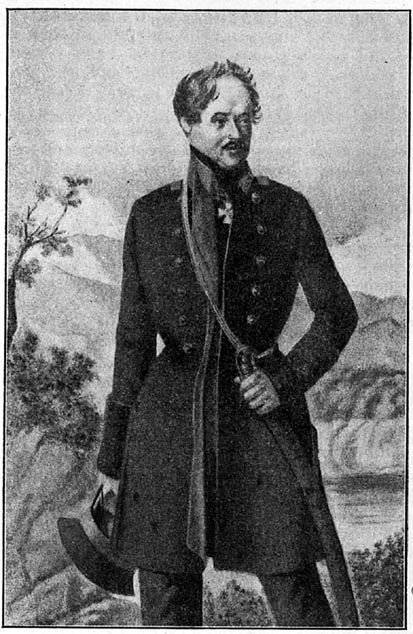
General Konstantin Yakovlevich Belyavsky (1802 — 1857)
Meanwhile, the Turks recovered and attacked Belyavsky's infantry again. Turkish artillery stepped up. The attack was led by three choke battalions, and at the foot of the mountain hit the Uhlan regiment. One of the Russian battalions lined up in a square to repel the attack of enemy cavalry. Ulan stopped. However, choke battalions, supported by the entire infantry of the right Turkish column, continued the offensive. The situation was critical. But, in this difficult moment, the Nizhny Novgorod Dragoon regiment under the command of Major General Prince Chavchavadze struck the enemy. Colonel Tikhotsky struck the line of choke battalions on the left, and Colonel Prince Dondukov-Korsakov with two divisions on the right.
At the same time, Colonel Dolotin sent one of the Don artillery battalions under the command of Esaul Kulgachev to help. Carte salvo made terrible devastation in one of the Turkish battalions. But, the Turks immediately answered. The battalion fire put in place most of the servants and horses of the division. Esaul could take out only two guns. Two guns were captured by the Ottomans. The dragoons immediately rushed to the rescue. Nizhny Novgorod across the ranks of enemy lines, destroying almost completely the entire Turkish battalion of the Arabistan Division. However, to rescue guns could not. In this fierce battle, the Nizhny Novgorod regiment lost an 23 officer from 33 killed and wounded, and half of the lower ranks were out of action. The Nizhny Novgorod regiment supported the Tverskoy regiment, which regrouped its forces.
At this time, Bebutov was informed of the movement of significant enemy forces, bypassing our right flank. The commander put a barrier under the command of General Baggovut. He was assisted by a division of the Tver Dragoon Regiment, three hundred Don Cossacks and rocket teams - the artillery of the Russian corps included 16 rocket launchers (new weapon at the time).
The battle on our left flank continued. Without paying attention to the Turkish fire from the mountain, Belyavsky directed all the action of his artillery and archers to the Turkish uhlans and forced them to retreat. Then he led his battalions to the bayonet attack. The Turks, already upset by the fire of the Russian artillery, began to withdraw their artillery. The Nizhny Novgorod dragoons, taking advantage of the general confusion of the enemy, again struck the choke battalions, overturned them, beating our 2 and seizing enemy guns with 4. At 8 in the morning, all the right Turkish wing retreated. Turkish offensive on the right flank failed. The fact that the columns of the Turkish army were not interconnected among themselves greatly helped the Russian troops.
Seeing the retreat of the column Kerim-pasha, the battalions of artillery-chokers left Mount Karayal, so as not to be cut off from their main forces. The two divisions of the Novorossiysk Dragoon Regiment under the command of Lieutenant Colonel Streletsky with 4 guns overturned bashi-bazouks that still remained on the mountain. After that, a part of Novorossiysk dragoons was transferred to the right flank. Bebutov ordered Belyavsky not to get involved in pursuing the enemy and get in touch with the center in order to repel the blow of the enemy's left column. Belyavsky's troops moved to the right.
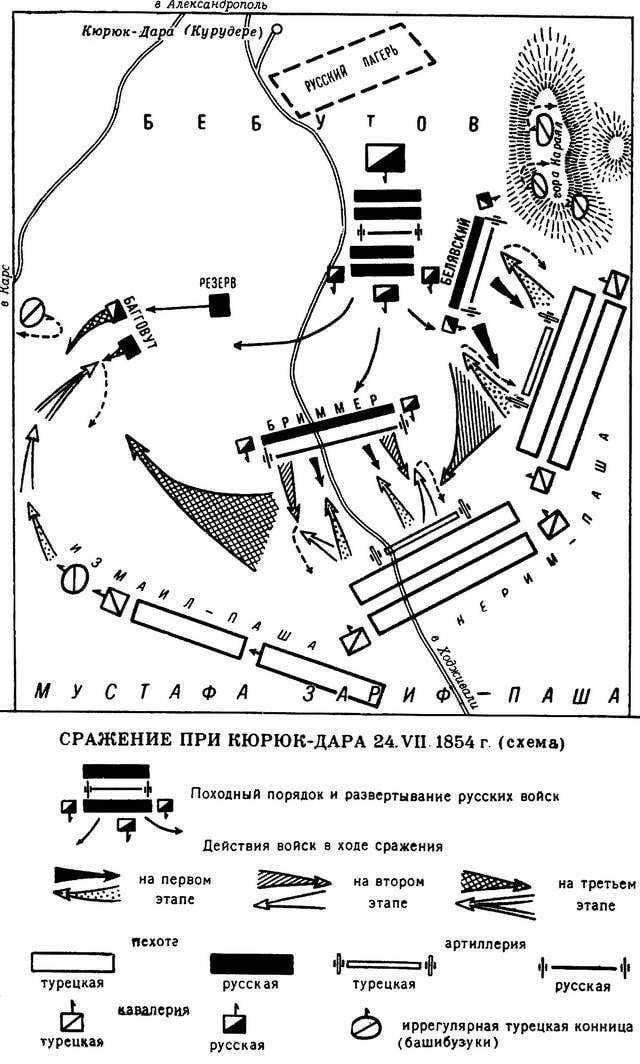
Centre. While on the left flank, Belyavsky was engaged in a battle with the enemy’s right column, in the center of the battle the troops were led by Lieutenant General Brimmer. The Turks lined up here in three infantry lines (the third was a reserve), three batteries were put forward in the infantry intervals, the cavalry stood behind the infantry.
First artillery duel ensued. Brimmer advanced our artillery at a distance 450 fathoms from the enemy. From the Turkish army, they fired 18 guns from the front and 12 guns from the right flank. Then the general moved the guns to a distance of about 250 fathoms. Our gunners acted under the command of Colonels Lagoda and Voronkov and Lieutenant Colonel Brieskorn. Major-General Kishinsky, the commander of the Caucasian Grenadier Brigade, was wounded. However, he was on the battlefield almost to the very end of the battle.
After the shootout, the Caucasian Grenadier Brigade went on the attack. “Brothers! - said Brimmer, referring to the grenadiers - now we move closer. Look, work friendly with bayonets! ”In response, thunderous“ hurray ”thundered. Generals Baryatinsky and Brimmer led the Russian soldiers to the bayonets. It was something - the grenadier and carabinieri 7 battalions broke through the three lines of the Turkish battalions 20! A large role in the breakthrough was played by artillery, which practically shot the Ottomans at close range with the canister.
I must say that the Ottomans fought hard. The fight was fierce. For example, the 1 Battalion Carabinieri rejected the 4 Battalion of the Arabistan Division, but could not break through the second line. General Chisinau, exhausted from the loss of blood, rushed to the aid of two companies of the 4 grenadier battalion and broke through all the lines of the enemy. Both sides suffered heavy losses during the unarmed combat. So, the 2 Grenadier Battalion attacked another regiment of the Arabistan Division and lost the 450 man within a quarter of an hour. The battalion was threatened with encirclement and complete extermination if it were not for the support of the 3 Battalion of the Erivan Carabinier Regiment of Lieutenant Colonel Prince Tarhanov and 2 of the guns of Captain Dudarov, who showered the enemy with a canister. The Arabians were overthrown, and their banner seized. The grenadier brigade broke down the resistance and forced the enemy troops to flee.
The last fights took place on our right and left flank of the center. Here the Turks tried to bypass the grenadier brigade. The Russian troops on the right wing headed by Baryatinsky. First, the Russian infantry withstood the shelling of Turkish artillery, and then attacked the lancers. Baryatinsky built the 2 th carabinier and 1 th grenadier battalions in the square. Reflecting the cavalry attack, the Carabinieri attacked the enemy artillery, forcing it to retreat. Then the Russian infantry repulsed the attack of two Turkish battalions, which rushed to defend their guns. At this time, the Turkish lancers attacked again and went to the rear. To discard them, Bebutov threw into battle two noble squads of his own convoy, which were in reserve. Turkish cavalry overturned.
On the left flank, an attempt by Turkish troops to bypass the grenadier brigade was reflected by the artillerymen of the 4 battery and the arrows of two companies of the 4 battalion of the Erivan regiment. In addition, they were supported by Tver dragoons and 4 guns of the Don artillery.
As a result, the victory was in the center of the Russian troops. At 9, the morning Turkish 20 of the best Turkish battalions supported by artillery and cavalry were knocked down and ran. But, here too, the Russian troops could not pursue the enemy, practically having no cavalry in the center and under the threat of a grip from the right flank, where a Turkish column, equal in number to the whole Alexandropol Corps, advanced.
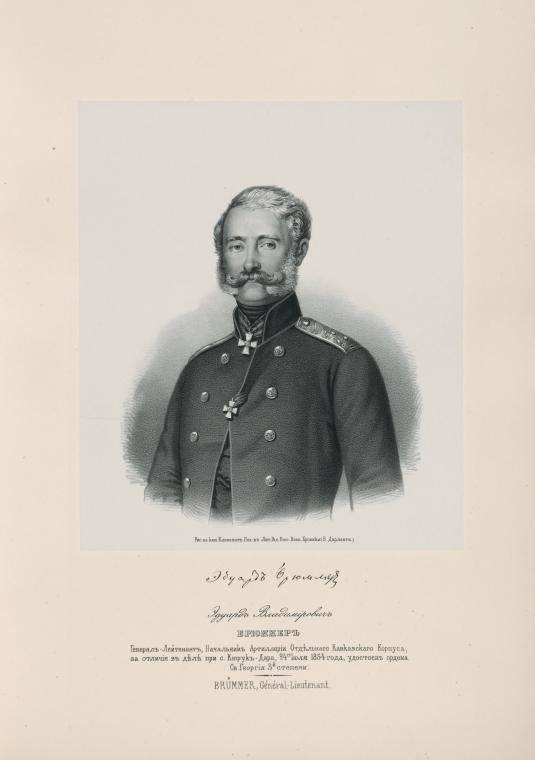
Artillery General Edward V. Brummer (Brimmer) (1797 — 1874)
Right flank. Already when the Turkish troops defeated the Russian left flank and in the center the grenadiers launched an offensive, the left wing of the Turkish army launched an attack. In 8 hours, the masses of bashibuzuki pressed the Cossacks and the police, trying to enter the rear of the corps. Prince Bebutov sent the Ryazhsky regiment to the right wing of the 6, the artillery division and ordered Lieutenant General Baggovut to head the barrier. General Baggovut led reinforcements - the division of the Tver regiment, three hundred Don Cossacks and two cavalry-rocket teams.
In the meantime, the bashi-bazouks, supported by regular cavalry, infantry, and artillery, continued to push back our equestrian cover. Baggovut strengthened the cavalry on the right wing of the infantry, on the left - dragoons, Cossacks and artillery. Horse-rocket teams, under the cover of Cossacks, opened fire on bashi-bazouks. It was an important day at stories rocket artillery. Issued from special machines rocket, for which in flight stretched a long smoke plume, horrified the sultan's soldiers. The losses from the fragments during the explosions of the "tail" projectiles were greatly complemented by the losses of the psychic. The rockets made panic and horror at the wild bashi-bazouks, they ran.
General Baggovut, under which two horses had already been killed, led the cavalry into attack: Colonel Kamkov's Combined Linear Regiment, three hundred Lineans (Cossacks) Colonel Skobelev, an equestrian Muslim brigade, of five hundred Lieutenant Colonel Edigarov, Tver dragoons and Don Cossacks. Russian cavalry scattered the whole mass of the Turkish cavalry, which was trying to circumvent the Alexandropol Corps. Line Skobelev captured three enemy guns. They tried to recapture the Turkish Ulan regiment, but was attacked from all sides and almost completely cut down.
The Turkish infantry was also shaken by the onslaught of the Russian cavalry. This took advantage of the company Ryazhsky regiment. They went on the attack, and with the support of squadrons of the Novorossiysk Dragoon Regiment and the Cossack artillery battalion overthrew an entire Turkish regiment. To complete the defeat of the enemy, Bebutov threw into the battle the 1 light battery of the Caucasian Grenadier Brigade, two battalions of the Tula Regiment, two divisions of the Novorossiysk Dragoon Regiment with 4 guns of Don artillery. The artillery upset the Turkish infantry, the Tula infantry struck bayonets, dragoons, Bebutov's convoy and volunteers (policemen) entered the flanks. The Ottomans could not resist such a friendly onslaught. The dragoons captured the 4 guns and covered the entire field with enemy corpses. The persecution was stopped only in the first hour, when people and horses were completely exhausted.
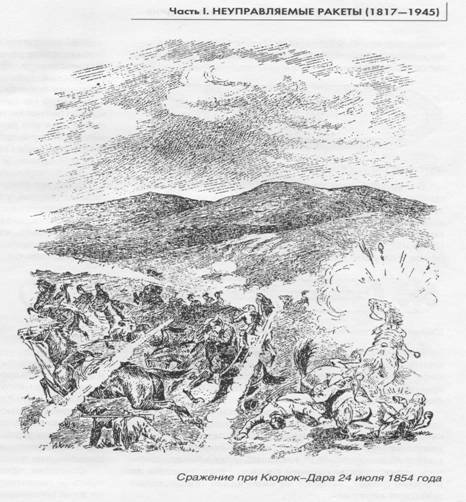
Results
It was a complete victory, albeit at a heavy price. The defeat of the Anatolian army was given to experienced Caucasians with great difficulty. It is not by chance that the newspaper Kavkaz noted: “The Ottomans showed such resistance that the old campaigners never saw from them.” The Alexandropol Corps won, but suffered significant losses - about 600 people were killed, more than 2,4 thousand wounded.
Anatolian army in a bloody battle lost 5 thousand people killed and captured. 2 thousand people were taken prisoner. According to others, the losses of the Turkish troops amounted to 10 thousand people. Around 12, thousands of bashi-bazouks and Kurds fled, deserting from the army. The defeated Turkish army fled to Kars. Russian trophies were 15 guns with 16 charging boxes, two banners, four standards and twenty badges, a variety of firearms and cold arms (including English and French fittings).
Bebutov for this feat was awarded the Order of St.. Andrew the First-Called, Prince Baryatinsky and the commander of artillery, Lieutenant-General Brimmer - orders of St.. George 3 degree, Major General Kishinsky - Order of St. George 4 degree.
Victory in the Battle of Kyuryk-Dara was of strategic importance. The 1854 campaign of the year was won by the Russian army. Port and its Anglo-French advisers were unable to realize plans to seize Transcaucasia and the lands to the north. The Anatolian army was no longer capable of conducting offensive operations. However, the Alexandropol detachment did not have the strength to assault Kars, who defended the 40-thousand. garrison. Therefore, Bebutov was forced to stop the offensive, and then withdraw the troops, when the enemy landed strong reinforcements for the Anatolian army in Batumi. At this point, the 1854 campaign of the year was completed.
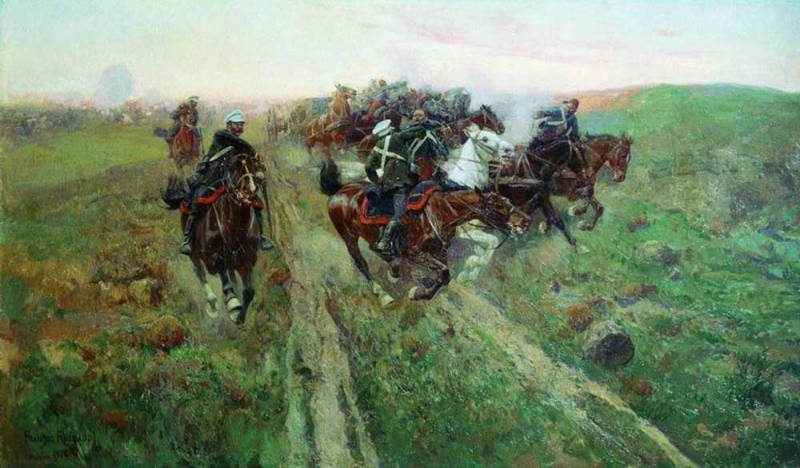
Episode of the Battle of Kyuruk-Dar. 1900, F.A. Rubo
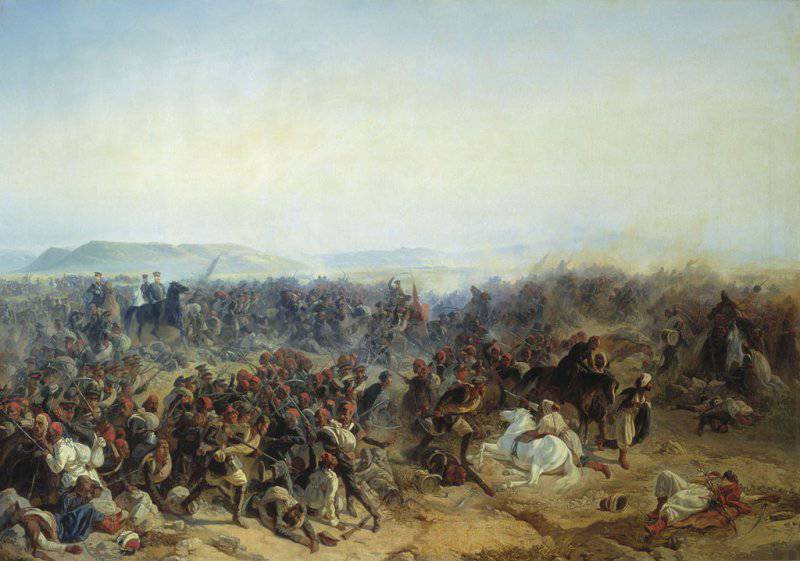
Information